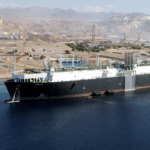Energy News Beat
I did not have this on my bingo card for stories, but here we are. The following is a LinkedIn post from Doug Sheridan, and I highly recommend following him on LinkedIn. AI is going to be critical in many ways, and we are seeing the grid go to decentralized and microgrids. The explanation of Stargate’s turbine solution for the power plant is an example of American ingenuity.
Bloomberg writes, if Stargate’s first AI data center is completed next year as planned, the 900-acre site will rely on generation technology that’s largely been relegated to the sidelines of power production—small, simple cycle natural gas turbines.
That’s because the AI boom—which has supercharged electricity demand—is unfolding faster than power plants can be built and new grid connections established.
The venture by OpenAI, Oracle and Softbank is bridging the gap by stringing together a dozen of the small generators to power the Texas facility. Other city-sized data centers, including xAI and Alphastruxure, a JV between The Carlyle Group and Schneider Electric, are doing the same.
The trend has sparked an unlikely comeback for a type of gas turbine that long ago fell out of favor for being inefficient and polluting. It also lays bare a critical disconnect between the growth of AI and the state of the US power sector.
Tech companies had pledged to go green. At the same time, aging power infrastructure means there’s a years-long wait to connect and tap power from electric grids. And nuclear—now in huge demand from tech giants—is unlikely to provide much new power anytime soon.
“There is a high level of urgency in the industry to get power fast,” said Cully Cavness, co-founder and COO of Crusoe, which is building the first Stargate project. “We have tried to be creative about the energy component of data centers.”
Concerns about the reliability of renewable power have led many developers to favor gas-fired power, which can run 24-7. Consequently, orders for bigger, more efficient gas plants—combined-cycle turbines—have surged, creating a manufacturing backlog of three to five years, with an additional year to bring them online.
So data center developers are scrambling to snag whatever turbines they can, which usually means single-cycle, in the range of 100 to 200 MW. Mitsubishi Power and Siemens Energy are seeing buyers clamor for smaller units, typically 70 MW or lower, for delivery as early as 2025-2026. And GE Vernova has seen increased demand for simple cycle units with the option to upgrade them to the more efficient combined cycle equipment.
Even orders for small turbines are starting to back up, spurring developers to snap up ever-tinier machines, such as off-the-shelf jet engine turbines, with capacities of as little as 5 MW.
Projects such as Stargate that ultimately plan to connect to the local grid will at that point start using these smaller gas turbines as back-up power and to provide services to help keep that grid stable, said Cavness.
Our Take: Just to be clear, the world’s most sophisticated companies aren’t turning to the newest and best wind and solar technology to power their most important projects ever. Instead, they are turning to some of the oldest, most basic and inefficient gas-fired technology—simple cycle turbines, including those used as jet engines. Noodle on that, folks.
The post AI and Data Centers – DOA without old natural gas turbine technology appeared first on Energy News Beat.









